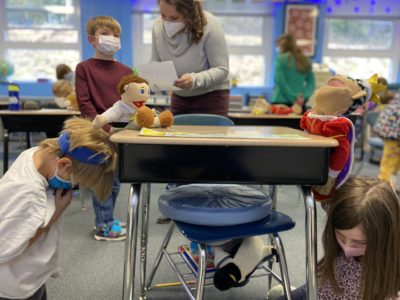The recent pandemic has changed the landscape of education. Although many schools across North Carolina are now offering hybrid instruction or returning students to full time, in-person learning, how can the lessons learned from the remote experience be used to strengthen instructional practices regardless of the physical environment in which students learn?
This past year, teachers grappled with new strategies to keep students engaged, and students had to rely on self-regulatory behaviors to remain focused on their computer screens and avoid home distractions for hours throughout their day.
Teachers began making great strides in making Zoom presentations more interactive and fun for students, but for many educators, the struggle to see the faces and hear the voices behind the avatars remained.
How to measure and increase student engagement became a topic of priority. While student engagement was a challenge for most, I found myself in a more fortunate, positive remote teaching experience.


My students participated and engaged both with their classmates and me with their web-cameras and microphones on. My reflection on this success led to further engagement research and the belief that arts education models could help teachers understand how to increase engagement in any class.
The safe environment
All teachers believe they are creating a safe learning environment for students, but how are students experiencing this to be true? In the arts, the evolution of student performance is witnessed by both the classroom teacher and peers as students develop work through a creative process.
Arts students are expected to take risks and even fail in front of their peers in their attempt to master new skills and learn how to improve and form their final work of art. Criticism is openly shared by the teacher and students as they discuss how to refine performance.
Building a supportive culture where students experience feelings of trust and encouragement and are open to giving and receiving positive, constructive feedback requires teacher leadership. Supportive attitudes need to be modeled to students and developed through small lessons that occur frequently throughout the year, especially in the first few weeks of a class.
Discussion board posts, journal writing, and small group discussions are great ways to help students become more aware of how they contribute toward the creation of a safe space for all learners. Having students individually reflect and openly discuss strengths and growth areas of group interactions and student performance fosters a collective growth mindset.
Such activities not only help them identify their needs to feel supported, but create awareness of the active role they have in supporting everyone in the class. When students can hear from teachers and peers that they are in a judgement-free zone, and this becomes an agreed norm, it eases anxieties that often block risk-taking and learner confidence.
Relationships
Relatedness is another factor that leads to engagement. Teachers know the importance of developing relationships with their students, but perhaps not enough emphasis is placed on the value of strengthening relationships between students in education today.
Performing arts education students develop social bonds with peers by working closely with one another towards the mastery of group goals. As educators place value on the need of all students’ participation and contribution to reach shared visions and goals, they help students develop a strong social identity and sense of community in viewing themselves as part of an ensemble.
Creating this sense of belonging in a classroom positively influences engagement and interdependence, and is an essential component to social and emotional learning. Building a peer-driven, team approach to learning increases student accountability and performance as students strive for the overall success of the group.
Autonomy
Arts students are often given autonomy to apply their learning in the development of their own work within their craft. Encouraging student choice and individual expression through compositions of visual and/or performance artwork permits students to connect to their learning in more meaningful ways.
Giving students agency leads to increased engagement as material becomes more relevant and personal to their lives. Students also develop a greater sense of pride in their work when they succeed at creating and producing something that is a representation of themselves.
Whether students are given autonomy in individual or group learning activities, decentralizing classroom leadership and giving students the freedom to apply their learning in more personalized ways leads to their increased engagement.
Efficacy
Students who believe in themselves often perform better. According to many social learning theories, competency belief is one of the three factors that lead to increased student engagement. How teachers help students develop confidence in their capabilities is paramount. Like a great coach, it begins with the language and words of encouragement and the way in which educators demonstrate faith in their students.
Students do not want to let down those who believe in them. Efficacy is strengthened when students meet high, realistic expectations and can frequently celebrate both small and large successes. Success breeds success, as a psychological momentum of both individual and collective efficacy.
Performing and visual arts students build efficacy as they master new skills in the classroom and ultimately as their work is shared publicly with others and positive affirmation is received from their audience. Providing students with the opportunity to demonstrate and celebrate success helps them build competency beliefs, which become another influence on their engagement.
In practice
Over the past semester of remote instruction in a public high school dance program, students were most likely to turn their web cameras on daily and actively engage with their teacher and classmates when they felt they were not going to be judged by their peers. They understood the value of their active participation in the need for the success of the whole.
Individual responsibility and personal accountability in terms of student attendance, preparedness, and communication increased as students became interdependent on one another while working in small groups over the course of a semester. Students took agency in creating their own group chats so that they could support and assist one another with their projects outside of scheduled instructional class time.
As students developed trusting relationships, they more easily collaborated on learning tasks by sharing knowledge and personal ideas with group members, having group discussions, and making collective choices on how to demonstrate their mastery of course content.
When student groups virtually performed for one another, classmates used the chat feature to give encouragement and positive feedback. Student reflections and survey data showed that students felt connected to their peers, supported, and successful in the class.



